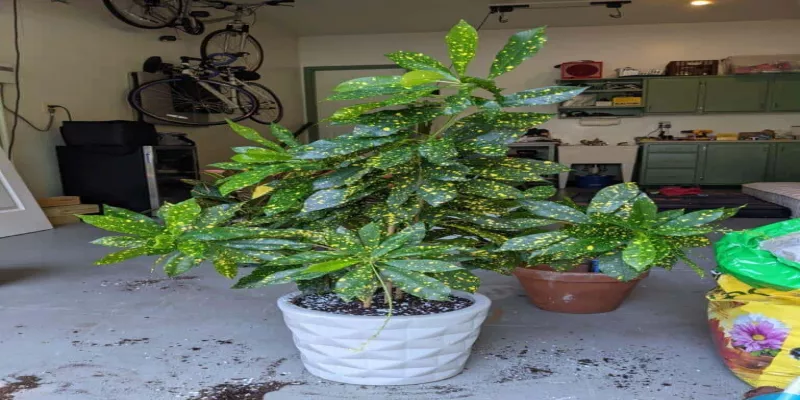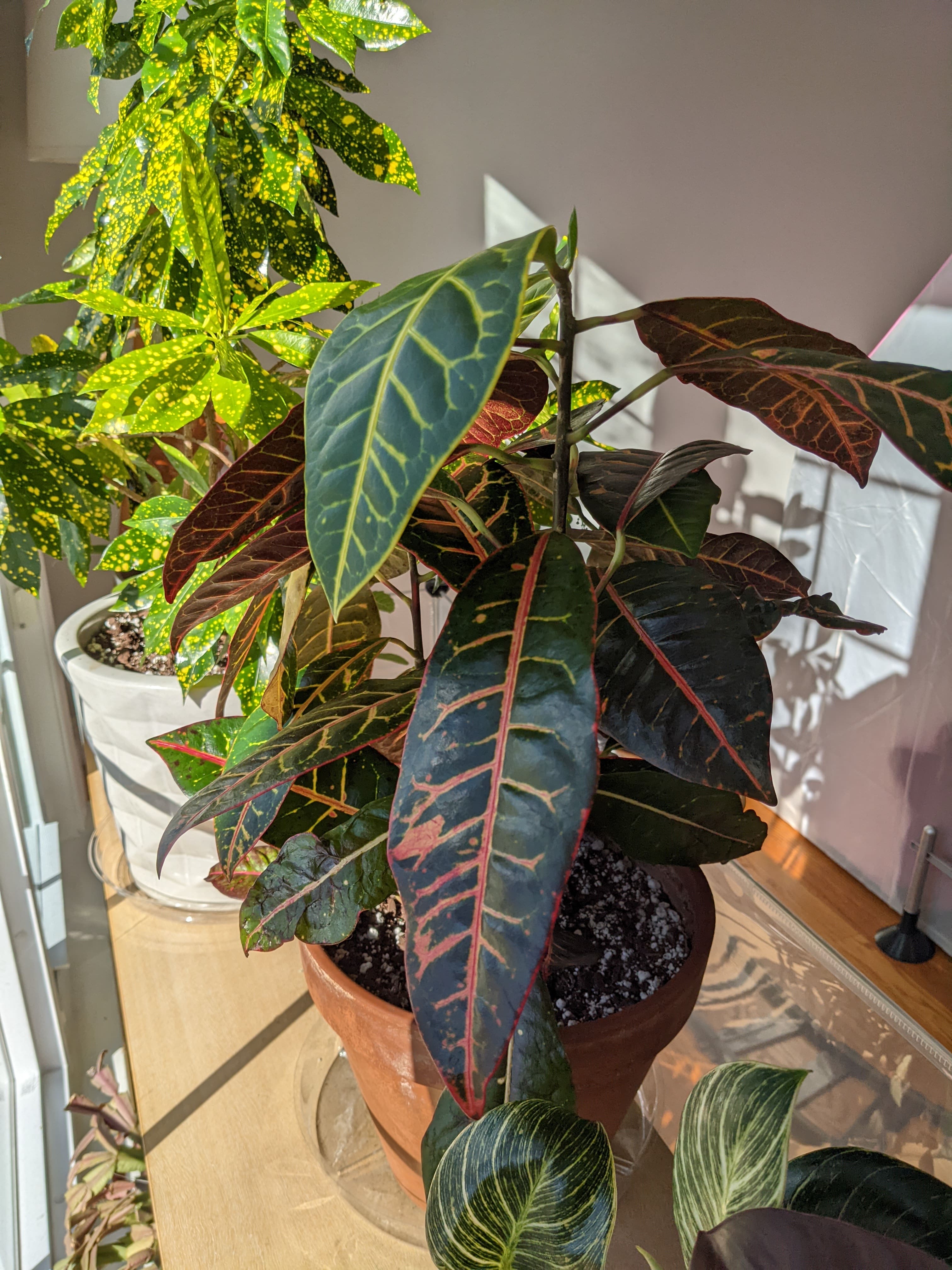Croton Plant Indoor Care

Croton plants have beautiful foliage that varies in size, shape, and color patterns. It's no wonder they are a popular house plant that you can find at many big box stores and plant nurseries. While their unique beauty makes them popular, they can be a challenge to care for indoors. If you're lucky enough to live in growing zones 9-11, you can also grow them outdoors as a perennial. If you live in a lower-numbered zone expect to bring your Croton in for the winter or treat it as an annual. In this post, I'll go over the basics of Croton Plant indoor care.
Back to topCroton Plant Indoor Care
Croton Plants can be easy to care for once you get their specific needs worked out. They have a reputation for being dramatic which frustrates many indoor plant lovers. In my experience, they do have a lower tolerance for deviation from their optimal light, water, and fertilization needs compared to other popular houseplants. The Gold Dust Croton pictured above is one of my oldest plants. I got it at a Home Depot when it was probably six inches tall and now is over three feet! For those of you looking for the quick basics of Croton Plant indoor care, it can be found in the table directly below. I'll also go into more detail for each category further below as well. One other note is that Crotons are not safe for your pets to ingest, so be mindful of where you place them.
| Light Needs | Watering Needs | Soil Needs | Fertilizing Needs |
| Direct or bright indirect light. | The top inch of soil should be dry before watering. | Well draining potting soil. | Every 2- 4 weeks during the growing season. |
Croton Plant Light Requirements
Crotons are sun-loving plants. Ample sunlight helps Crotons to produce the vibrantly colored leaves that are their signature. If your Croton is growing leaves but the leaves turn out mostly green once they are full-size, then your Croton is not getting enough light. However, don't panic if your new leaves appear green when they are small, they can take a little time to gain their color.
Croton light requirements are pretty simple. It will do best as close to the window where you get the most sun in your home. For the first several years I kept my Gold Dust Croton in a west-facing window, then moved it to a south-facing window a few years back. It noticeably took off once I put it in the southern window. Windows facing south receive the most direct sunlight if you are in the northern hemisphere. If you're lucky with sunlight, you may be able to get your Croton to Bloom like mine.
If you're not sure which direction your windows face you should be able to tell by opening up a map app on your phone. There are also plant monitors that can help you determine which window gives the best light. I personally like this plant monitor. It has an app, so you can just stick it in the soil and it will measure the light accumulation by the hour, which gives you more than enough information to compare different spots in your house for light suitability.
Back to topCroton Plant Watering
Croton watering can be tricky. I'm the type of plant person that keeps my plants on the dry side. I mainly do this to 1) try to stick to a schedule and 2) to prevent fungus gnats who really love moist soil. Unfortunately, Crotons require evenly moist soil. Despite my many attempts, they cannot be put on the same watering schedule as every other plant I have. Every few days my Crotons' leaves will start to go limp (see below my Croton Petra for an example). Remember I called them dramatic? Then I have to give them a quick sip of water to tide them over until normal watering day for the rest of the crew.

The general rule you will hear for watering is to wait for the top inch of soil to feel dry before you water your Croton. I personally don't like getting dirt under my fingernail every day, so I highly suggest a soil moisture meter. This is probably my most used plant tool. It's definitely made me better at knowing how often to water and how much water to give each of my plants because you get an idea of how quickly it's drying out. If you're having issues with your Croton leaves like drooping or they're turning yellow. The first culprit is a watering issue. Check out my blog on yellowing leaves if you think your Croton is having watering problems.
Back to topCroton Plant Fertilizer
Indoor Crotons can be fertilized about every two to four weeks from spring to fall. And you can follow that same fertilizing advice if you summer your Croton outdoors. While your Croton might grow a new leaf or two during the winter as an indoor plant, you don't really want to encourage it with fertilizer, because it won't be getting adequate light in the winter.
Croton Plants should do well with an all-purpose balanced fertilizer. A balanced fertilizer is one that has even, or very close to even, ratios of the three nutrients n-p-k. N-P-K is nitrogen-phosphorus-potassium. If you're really looking to improve foliage growth, then nitrogen is the nutrient for that. In addition, if you suspect you have Croton fertilizer issues, you can test for each nutrient using soil rapitests.
Back to topCroton Plant Soil
You do not need a specially formulated soil mix for Crotons. This is one area where I have found I can treat Crotons exactly like all my other plants. Generally speaking, you want a well-draining soil mixture. I usually start with regular potting soil and amend it with a little extra perlite. Perlite is the little white stuff you find in most potting soil and it helps with drainage. I typically use a 4:1 ratio of potting soil to perlite.
The most important thing is that your soil is in a pot that has drainage holes. Using a pot without drainage is asking for trouble. While Crotons like moist soil, they won't do well if they cannot dry out a bit. If you're looking into soil, you may be interested in repotting your Croton. I have a step-by-step tutorial on repotting the Gold Dust Croton from above. These plants can grow pretty slowly, especially indoors though, so you really only need to repot them every other year or so.
Have questions about Crotons? Let us know in the Comments section below.
Back to top
Add new comment